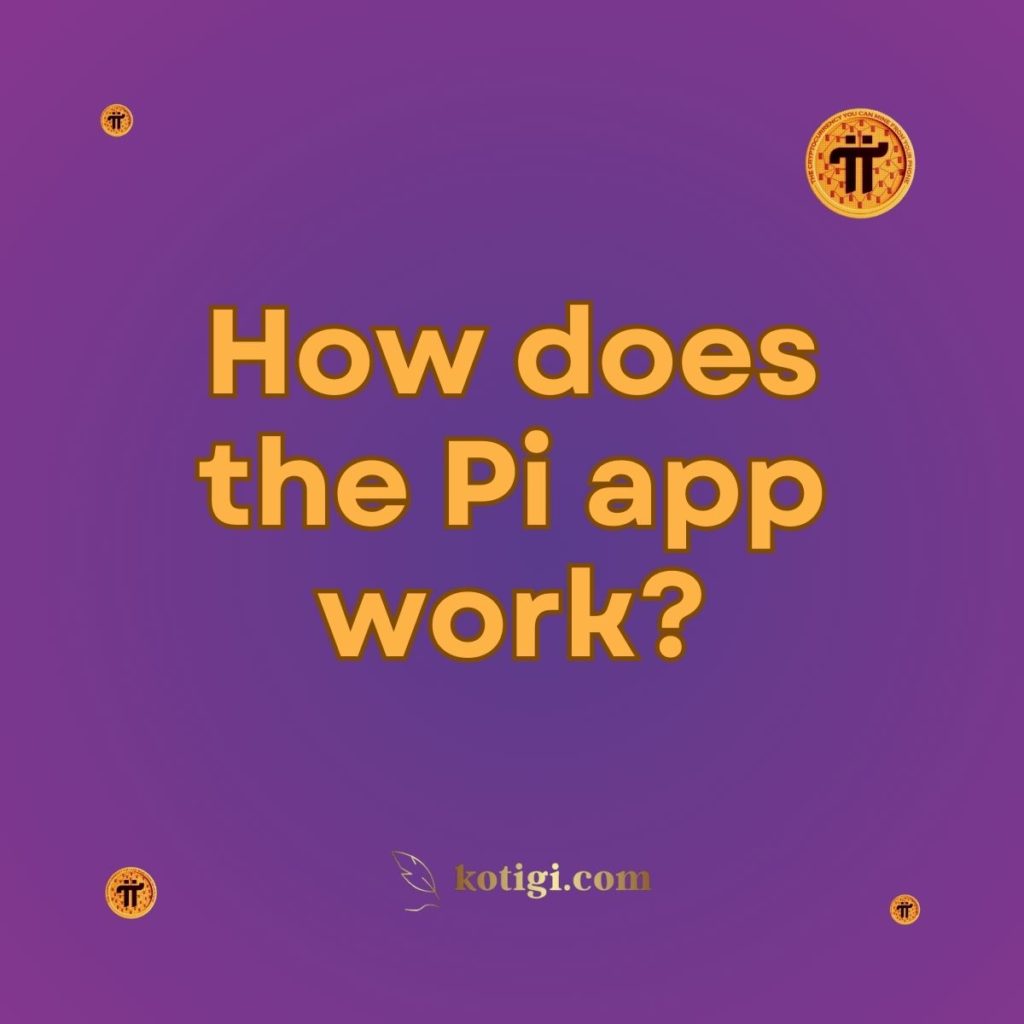
How does the Pi app work?
The Pi app allows users to mine Pi cryptocurrency from their mobile phones without consuming significant energy or resources. By tapping a lightning button once every 24 hours, users can participate in decentralized mining through a trust-based system, all while the app runs efficiently in the background.
Introduction
Cryptocurrency mining has traditionally been associated with powerful hardware, high energy consumption, and technical expertise. However, Pi Network has turned that idea on its head with a mobile-first approach to mining. The Pi app allows everyday users to mine Pi cryptocurrency on their smartphones with minimal effort and no complex setup. But how exactly does the Pi app work, and how is it different from traditional mining methods? In this post, we’ll break down the core functionality of the Pi app, how users mine Pi, and what sets Pi Network apart from other cryptocurrencies.
What Is Pi Network?
Before diving into how the Pi app works, it’s essential to understand what Pi Network is. Launched by a group of Stanford graduates in 2019, Pi Network aims to make cryptocurrency accessible to the masses. While many cryptocurrencies require users to invest in expensive hardware and consume large amounts of electricity to mine, Pi Network is designed to allow users to mine Pi from their smartphones.
The Mission of Pi Network
Pi Network’s primary goal is to create a decentralized digital currency that can be mined by anyone with a smartphone. By removing the barriers to entry, Pi aims to democratize access to cryptocurrency, making it as easy to use as popular mobile applications. This user-friendly approach has helped Pi build a large community of users, even though the Pi cryptocurrency is still in its early phases and has not yet been fully listed on public exchanges.
Why Pi’s Approach Is Different?
Unlike Bitcoin and Ethereum, which rely on energy-intensive proof-of-work (PoW) models for transaction validation and mining, Pi Network uses a novel consensus algorithm called the Stellar Consensus Protocol (SCP). This allows Pi to achieve security and decentralization without consuming massive amounts of energy, making it a greener and more accessible cryptocurrency.
How to Get Started With the Pi App?
Mining Pi through the app is designed to be simple and straightforward. Here’s how you can start using the Pi app.
Step 1: Download the App
The first step to joining Pi Network is to download the Pi app, which is available on both iOS and Android platforms. Once you’ve installed the app, you will need to create an account. The registration process is simple and involves providing basic information, such as your name, phone number, and email address. You will also need an invitation code from an existing Pi user to join the network, as Pi Network operates on a referral-based model to build trust.
Step 2: Start Mining Pi
After registering, you can begin mining Pi by opening the app and tapping the lightning bolt icon. This initiates a 24-hour mining session, during which you will earn Pi based on your role within the network. Once the session is activated, you don’t need to keep the app open or actively engaged. The mining continues in the background, and you will be notified when it’s time to start a new session the next day.
Step 3: Build Your Security Circle
One of the key features of the Pi app is its Security Circle. After you’ve mined for a while, the app encourages you to invite people you trust to form your Security Circle. This circle is important for validating transactions and ensuring the network’s security. Each user can add between 3 and 5 people to their circle, and your mining rate can increase as your circle grows.
How Pi Network’s Mining Process Works?
Pi Network’s mining process is fundamentally different from traditional cryptocurrencies that rely on proof-of-work or proof-of-stake mechanisms. Here’s a breakdown of how Pi’s unique mining system works.
Trust-Based Mining Model
Pi Network uses a trust-based consensus algorithm rather than requiring users to solve complex mathematical problems like Bitcoin mining. In Pi’s system, users form Security Circles consisting of individuals they personally know and trust. These circles help to validate transactions and secure the network. By leveraging these trusted relationships, Pi creates a decentralized system that does not require the massive computing power and energy that traditional mining systems do.
Roles in the Pi Ecosystem
In the Pi app, users can take on different roles, each affecting their mining rate:
- Pioneers: The most basic role, Pioneers are regular users who open the app and mine Pi by tapping the lightning button every 24 hours.
- Contributors: After three mining sessions, users can become Contributors by adding members to their Security Circle. This role helps to strengthen the security of the network.
- Ambassadors: Users who invite others to join Pi Network become Ambassadors. For each person they invite who actively mines, Ambassadors receive a bonus to their mining rate.
- Nodes: In the future, Pi Network will introduce Nodes, users who run decentralized Pi nodes on their computers to validate transactions and maintain the network.
Energy-Efficient Mining
One of Pi Network’s standout features is its energy efficiency. Unlike proof-of-work cryptocurrencies like Bitcoin, which require miners to use high-powered hardware, Pi Network’s consensus algorithm does not involve solving computational puzzles. As a result, mining Pi uses negligible energy and does not drain your phone’s battery or require you to leave the app open continuously.
Security and Privacy in the Pi App
Security and privacy are critical concerns in any cryptocurrency network. The Pi app ensures both by leveraging its Security Circles and decentralization strategy.
Security Circles and Trust
As mentioned earlier, Pi Network relies on Security Circles for its consensus algorithm. By forming a group of trusted individuals, you help Pi Network validate transactions and prevent fraudulent activity. This system ensures that only legitimate users are part of the network, reducing the risk of bots and fake accounts.
Privacy Features
The Pi app is designed to be privacy-conscious. It requires basic information for registration, but it does not collect sensitive data or share your personal information with third parties. Pi’s decentralized model also ensures that no central authority controls your data, which is a critical factor for privacy in the cryptocurrency world.
The Future of the Pi App and Network
Pi Network is still in its early phases, which means there are several exciting features yet to be rolled out.
Mainnet Launch
Currently, Pi is in its testnet phase, meaning that the cryptocurrency is being mined but is not yet traded on public exchanges. However, once Pi transitions to its mainnet phase, users will be able to trade Pi for other cryptocurrencies or fiat currencies. The mainnet launch is expected to occur once the network reaches a critical mass of users and its decentralized infrastructure is fully tested and operational.
Pi Nodes and Decentralization
Another feature on the horizon is the introduction of Pi Nodes. Pi Nodes will allow users to participate in running the decentralized infrastructure that powers Pi Network. Nodes will play a critical role in transaction validation, much like miners in traditional cryptocurrencies, but without the energy-intensive demands of proof-of-work systems.
Conclusion
The Pi app has made cryptocurrency mining accessible to millions of people around the world through its easy-to-use mobile interface. Unlike traditional mining, Pi Network’s innovative trust-based mining model allows users to mine Pi without needing expensive hardware, technical expertise, or high energy consumption. All you need is a smartphone, and by tapping a button once a day, you can participate in building the Pi Network.
As Pi Network moves closer to its mainnet phase and introduces new features like Pi Nodes, it’s clear that the Pi app is paving the way for a more inclusive and decentralized future in cryptocurrency. With its emphasis on security, privacy, and ease of use, Pi Network is positioned to become a significant player in the evolving world of digital currencies.
Key Takeaways:
- The Pi app allows users to mine Pi cryptocurrency by tapping a lightning button once every 24 hours, with mining continuing in the background.
- Pi Network uses a trust-based consensus algorithm, which makes mining energy-efficient and easy to access for anyone with a smartphone.
- Users can build Security Circles within the app to help secure the network and boost their mining rate.
- Pi Network is still in its early phases, with the mainnet and Pi Nodes expected to launch in the near future.





